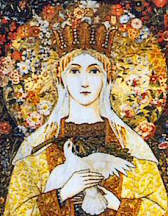Ordinary Time: January 24th
Memorial of St. Francis de Sales, Bishop and Doctor; Optional Memorial of Our Lady of Peace (Hawaii)
Other Commemorations: Our Lady of Peace
» Enjoy our Liturgical Seasons series of e-books!
Today is the Memorial of St. Francis de Sales (1567-1622), Bishop and Doctor of the Church. St. Francis' ardent love of God and souls, his great kindliness, rare wisdom and sure teaching made him exceptionally influential in bringing about conversions and in guiding souls in the spiritual life. He won back to the faith more than 70,000 heretics, thus restoring to the Church a great part of the Chablais, which had been ravaged by Protestantism. He was St. Jane de Chantal's spiritual director, and with her founded the Order of the Visitation. He is the author of Treatise on the Love of God and Introduction to the Devout Life. St. Francis died at Lyons in 1622.
The Diocese of Honolulu, Hawaii celebrates the Optional Memorial of Our Lady of Peace today.
St. Francis de Sales
 Francis was born on August 21, 1567, and ordained to the priesthood in 1593. From 1594 to 1598 he labored at the difficult and dangerous task of preaching to the Protestants of Chablais and effected the return of some 70,000 souls to the Catholic faith. In 1602 he became bishop of Genf. His zeal for souls is attested in 21,000 extant letters and 4,000 sermons which exemplify how he applied St. Paul's words: "I have become all things to all men." You may epitomize his character in two words, kindliness and lovableness — virtues that were the secret of his success. His writings reflect his kindheartedness and sweet disposition.
Francis was born on August 21, 1567, and ordained to the priesthood in 1593. From 1594 to 1598 he labored at the difficult and dangerous task of preaching to the Protestants of Chablais and effected the return of some 70,000 souls to the Catholic faith. In 1602 he became bishop of Genf. His zeal for souls is attested in 21,000 extant letters and 4,000 sermons which exemplify how he applied St. Paul's words: "I have become all things to all men." You may epitomize his character in two words, kindliness and lovableness — virtues that were the secret of his success. His writings reflect his kindheartedness and sweet disposition.
Most widely known is the saint's Introduction to the Devout Life, which, with the Imitation of Christ, is rightly considered the finest outline of Christian perfection. Francis' Introduction proves to the world that true piety makes persons amiable, lovable and happy. A renowned and holy friendship existed between him and St. Frances de Chantal. In cooperation with her he founded the Visitation Nuns in 1610. Out of love for his own poor diocese, he refused opportunities for advancement, including the cardinalate. In recognition of the Introduction and his other writings, Francis has been declared a doctor of the Church.
How Francis developed a gentle and amiable disposition is a story in itself; he was not born a saint. By nature his temperament was choleric, fiery; little was needed to throw him into a state of violent anger. It took years before he mastered his impatience, his unruly temper. Even after he became bishop, there were slips, as for instance, when someone rang a bell before he had finished preaching. The important point, of course, is that by constant perseverance he did in time attain perfect self-mastery. Wherein lies a lesson.
—Excerpted from The Church's Year of Grace, Pius Parsch
Patronage: against deafness; authors; Catholic press; confessors; deaf people; educators; journalists; teachers; writers;
Locations: Diocese of Baker, Oregon; Archdiocese of Cincinnati, Ohio; Diocese of Columbus, Ohio; Diocese of Wilmington, Delaware; Diocese of Oakland, California; Diocese of Houma-Theibodaux, Louisiana; Diocese of Annecy, France; Diocese of Keimoes-Upington, South Africa
Symbols and Representation: Bald man with a long beard wearing a bishop's robes holding a book; heart pierced with thorns or picture of the Virgin
Highlights and Things to Do:
- Read more about St. Francis de Sales:
- Read An Introduction to the Devout Life which is in print and also available online. CatholicSaints.info has a variety of sources either about or by St. Francis.
- Read more about St. Francis de Sales.
- Listen to Catholic Culture's audiobook of Introduction to a Devout Life read by James Majewski:
- Learn more about the errors of Calvinism and the Jansenistic heresy, both of which St. Francis' converted many followers.
- Learn more about the Salesian order.
- See the statues on St. Peter's Basilica Colonnade and Inside St. Peter's Basilica.
- St. Francis was born near Geneva, Switzerland, try a Swiss recipe in his honor.
- Catholic Cuisine has some clever food ideas for St. Francis de Sales.
Our Lady of Peace
 Our Lady Queen of Peace has been the patroness of the Catholic Church in Hawaii since 1827. The first Catholic missionaries to the Hawaiian Islands arrived at Honolulu Bay on July 7, 1827. These missionaries were members of the Congregation of the Sacred Hearts of Jesus and Mary and of Perpetual Adoration and upon their arrival in the islands dedicated their labors to the patroness of the Congregation, Our Lady Queen of Peace and placed the Islands under her protection. It was in her honor that these missionaries erected the first Catholic Church.
Our Lady Queen of Peace has been the patroness of the Catholic Church in Hawaii since 1827. The first Catholic missionaries to the Hawaiian Islands arrived at Honolulu Bay on July 7, 1827. These missionaries were members of the Congregation of the Sacred Hearts of Jesus and Mary and of Perpetual Adoration and upon their arrival in the islands dedicated their labors to the patroness of the Congregation, Our Lady Queen of Peace and placed the Islands under her protection. It was in her honor that these missionaries erected the first Catholic Church.
After more than a decade of contentious relations with the Hawaiian government, the missionaries were finally allowed to proceed with their evangelization work. In thanksgiving, the Cathedral of Our Lady of Peace was erected. Completed in 1843, a statue of Our Lady Queen of Peace was placed in the niche above the main altar. The Cathedral was solemnly blessed and dedicated to Our Lady of Peace on the feast of the Assumption, August 15, 1843.
The original statue of Our Lady Queen of Peace is located in the Convent Chapel of the Sisters of the Sacred Hearts in Picpus, France. During the troubled days of the Commune, in 1871, the populace, incited by atheistic leaders, invaded churches, chapels and convents, destroying every emblem of religion that fell into their hands. The chapel of Our Lady Queen of Peace became their prey. The Superior, with tears in her eyes, begged them to spare their beloved shrine; and, strange to say, the rabble went away, leaving it unharmed. When the tempest of the persecution subsided, the statue was again returned to its usual place and honored and venerated by a phalanx of devout souls.
On July 9, 1906, the statue of Our Lady Queen of Peace was solemnly crowned in the name of Pope Pius X by his Eminence Cardinal Amette, Archbishop of Paris. Every year on July 9 the feast of Our Lady Queen of Peace is celebrated with great solemnity in the Congregation of the Fathers and Sisters of the Sacred Hearts of Jesus and Mary and Perpetual Adoration.
During World War I Pope Benedict XV added the title Queen of Peace to the Litany of Loreto.
Highlights and Things to Do:
- Pray the Litany of Loreto. Find out more about this Litany and the feast on December 10.
- See the Cathedral of Our Lady of Peace in Honolulu, Hawaii.






